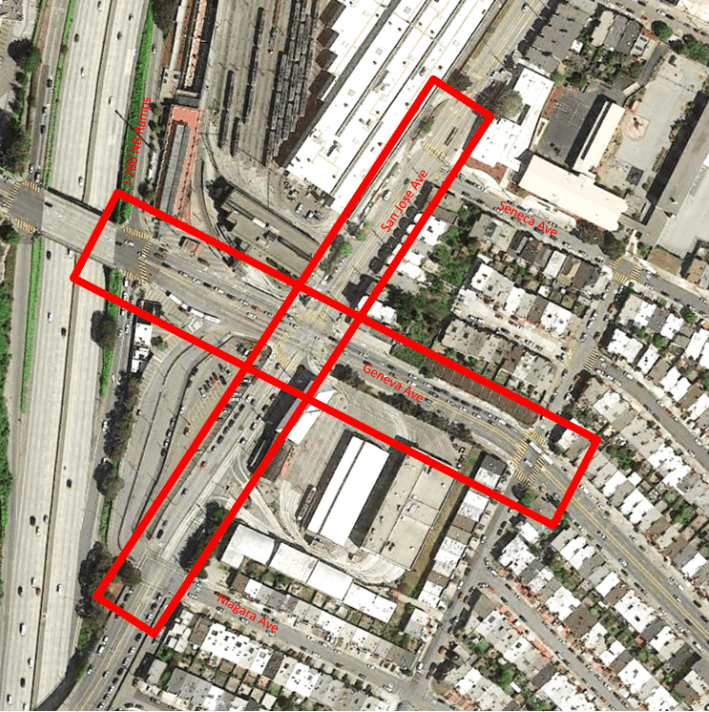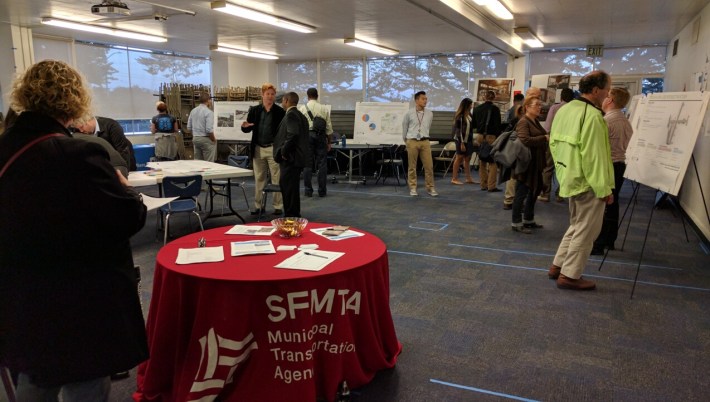Last night, SFMTA held an open house at Lick Wilmerding High School to get community suggestions on what to do about the mess of tracks, ramps, road and pedestrian crossings on and around the intersection of Geneva and San Jose, adjacent to the Balboa Park BART and Muni stations.
From SFMTA's project page:
The SFMTA is studying the area around the Geneva Avenue/San Jose Avenue intersection with the goal of developing short, medium and long-term improvements to transit access and safety for all users. Both Geneva and San Jose avenues are located on the City’s Vision Zero High Injury Network. This study will complement numerous projects underway in the immediate vicinity, including BART’s Station Modernization, the City’s Upper Yard Development and the City’s rehabilitation of the Geneva Car Barn. The study scope was developed in coordination with the Balboa Park Station Citizens Advisory Committee (BPSCAC) and District 11 Supervisor Avalos’ office.
This study will develop conceptual design improvements to address safety issues near the intersection. The analysis will include a focus on passenger access to Muni’s M Ocean View Line, which terminates within the Cameron Beach Yard on San Jose Avenue between Geneva and Niagara Avenues. This study will build upon past analyses and develop recommendations for improvements consistent with known plans.
Streetsblog readers will recall from an earlier post that BART is working concurrently to improve its part of the station (follow that link for more photos of the station and streets). For those not familiar with the area, the Geneva-San Jose intersection is part of a triangle of streets that also includes Ocean Ave. and is a crazy confluence of I-280's on and off ramps, the K, the M, the J-Church, BART, and a gaggle of bus lines.
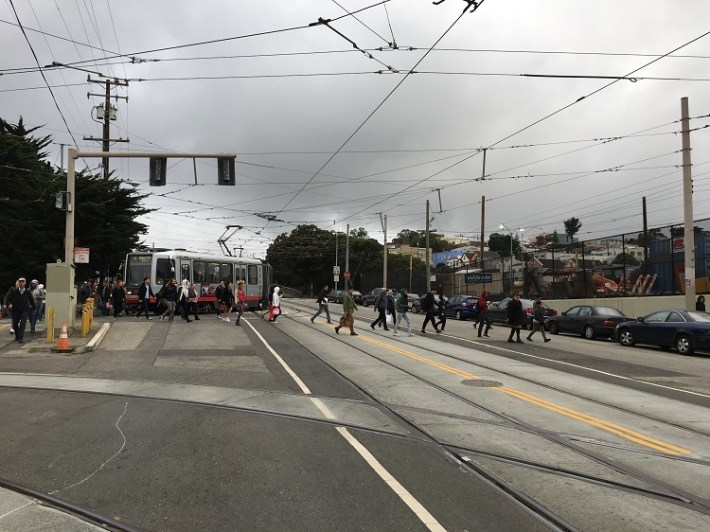
Transferring from mode-to-mode means dodging motorists flying off the freeway, not to mention Muni trains going in and out of the yard. Bike "infrastructure" is a bad joke, with a mess of half-worn-off sharrows and mixing zones that, frankly, are worse than nothing. As officials from BART explained, Muni trains were there first. Then came I-280. Then came BART. They were put in by different government bodies in different decades. There was never any coordination.
And, short of dropping a daisy cutter on the whole mess and starting over, nobody's quite sure what to do about it, except look for "low hanging fruit" that can be fixed without spending a billion dollars.
"We're starting with a blank slate," said Tony Henderson, Associate Engineer with the Sustainable Streets Division of SFMTA. "We want to learn from the community." The first step, explained Henderson and other public officials, is to hold these meetings and try to find out what the community would most like to see fixed.
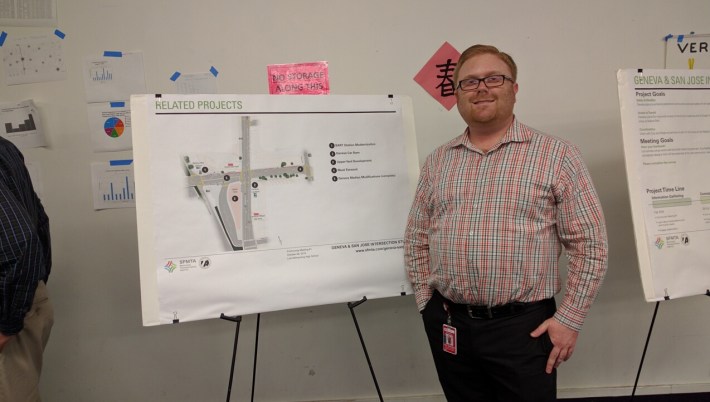
Of course, if the money existed, the first thing Streetsblog--and many of those visiting from the community--would like to see is a cap put over I-280, and the elimination of the off ramps on Geneva and Ocean, which continually put pedestrians and bikes at loggerheads with speeding cars. "There's a long history of plans. We did one on capping the freeway," said Bob Masys, a Senior Engineer with the San Francisco County Transportation Authority. Unfortunately, he explained, in addition to the huge price tag, that would require buy in from the Federal Department of Transportation, since it's an interstate. But that doesn't mean nothing can be fixed. Masys said they are looking at turning the ramps into signalized "T" intersections, to enhance the safety of pedestrians. But "there are no easy fixes," he said.
More traffic signals is exactly what Cathy Meyer, a local activist, wants to see--and not just on the ramps. "Add lights to Amazon and Mission, where there's just a stop sign," she said. That intersection, said Meyer, gridlocks and buses get backed up. She also wants to see serious traffic calming measures around the schools in the area, such as San Francisco City College and Lick Wilmerding High School, where the open house was held. "I support Vision Zero," she said, "But I think the dangers near schools go under-reported, because schools aren't open all year."
Constance Apamopoulos, meanwhile, wants to see protected bike lanes and intersections. "I have a 13-year-old and he still hasn't learned to ride a bike because it's so scary around here," she said. "We need bike lanes like you see in Holland." Dan Provence, Project Manager, said there is limited space on Geneva but they are looking at a protected bike lane, at least in the uphill direction. "We would love to have better bike facilities."
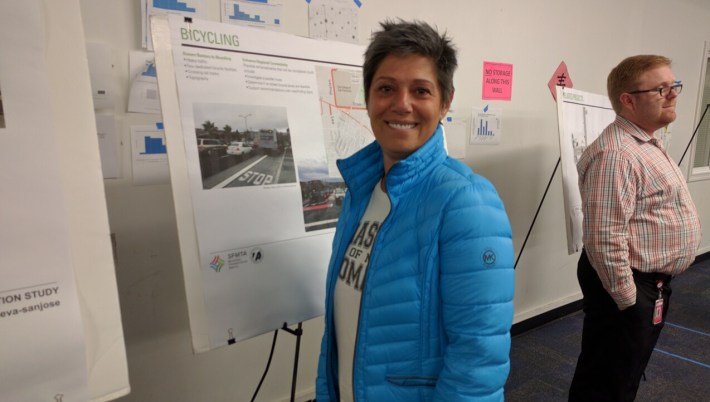
Streetsblog, meanwhile, took exception to the "limited space" argument against protected bike lanes. There's limited space, only if one continues to assume that parking lanes and car lanes can never be sacrificed--the width of Geneva varies, but in some stretches there are two parking lanes, four car lanes and a center turning lane. If free car storage (aka: street parking) has to be sacrificed so that Adamopoulos's son can ride a bike, then that's what needs done, especially on the approaches to a major transit hub. It should also be noted that the city is planning some 90 units of affordable housing on the Upper Yard parking site near Balboa Park station. Streetsblog isn't sure what the point is of placing dense housing close to transit if safe walking and cycling isn't going to get higher priority than privately owned motor vehicles.
Meanwhile, Reem Assaf, project manager with the San Francisco Rec & Parks Capital Improvement Division, was there to discuss plans for the Geneva Car Barn and Powerhouse, which were formally used as Muni offices, and are now being converted into a community arts and theater center. She said they are hoping to have the first portions ready for public use in the Fall of 2018. Streetsblog will bring readers more on this project in a future post.
Chuck Burwell, an analyst who lives in the area, said the city isn't thinking big enough. "This area really needs some radical thinking," he said. He said because Balboa Park Station isn't downtown, it tends to get less focus than it deserves. He'd like to see a Transbay-sized plan for the whole area, complete with housing development, a cap over the freeway, and separation of modes. He also argued for having Muni's trains run on an elevated track. "We're addressing small schemes, but we need a grand plan."

Streetsblog walked back up the hill after the meeting, to the west of Balboa Park on Ocean, along the route of the K line. Given the slope, it did seem as if it would work to have the K run to Balboa above street level, by rising above the dip of the natural terrain. Either way, Burwell had a point--it's okay to go after low-hanging fruit, such as signalizing more intersections, but as one official pointed out, decades of bad planning and total lack of coordination is what made it such a user-unfriendly and dangerous confluence of transit modes and roads to start with. It really does need a decades-long project vision, where the agencies can work on bits of it as money comes in. "It won't happen in my lifetime, but I need to know they're not shying away from a big project idea," said Burwell.
That said, these meetings could potentially result in a "grand vision"--if enough people show up, comment, and push for it.
If you missed the meeting but would still like to provide input, but sure to fill out SFMTA's online survey.
